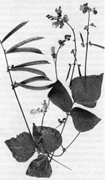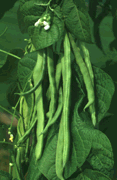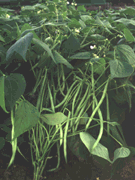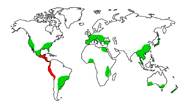Common bean (Phaseolus vulgaris L.)
Pea family
(Fabaceae)

| 
| 
|
Wild variety of common
bean (Phaseolus aborigineus) | String bean | Bush bean
|
Source: Brücher H., Trop. Nutzpfl., Springer Verlag 1977;
Wolf-Garten
Distribution, Yield, Use:
- Distribution:
The common bean is the most important economic
variety of the genus Phaseolus, and is grown in
all parts of the world. It requires much warmth and
sun. Cool weather and wind hamper the growth.
Medium heavy or light soils are preferred.
- Yield :
Green pods
180-250 dt/ha string beans
100-200 dt/ha bush beans
Ripe beans
10-15 dt/ha
- Use:
Foodstuff
- green unripe pods cooked, or conserved as vegetable
- ripe seeds cooked for soups, broth
5-15% dry mass, 1-3% protein,
2-6% carbohydrate in green pods
Ripe seeds contain
90% dry mass, 2% fat
55-60% carbohydrate, 20-25% protein.

Region of origin:  Region of cultivation:
Region of cultivation: 
- Cultivation and Breeding:
The common bean was already a cultivated plant in western South America around 800 BC. It probably arose from the Wild bean (Phaseolus aborigineus) found there. The Wild bean is a strong-growing creeper with small black seeds. The string bean was developed by the Indians through the selection of plants with less strong growth and larger seeds. The low, shrub-like bush bean was bred from the string bean in modern times.
- Breeding aims:
Important breeding aims are the improvement in protein content and composition, and the introduction of resistance characteristics into the high-yielding cultivated varieties. It is hoped that beans which are free of the poison phasin can be grown, which could then be eaten raw.
Text by
Dr. Wolfgang Schuchert
Adapted to HTML by R.Saedler




 Region of cultivation:
Region of cultivation: 